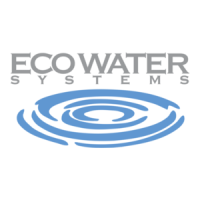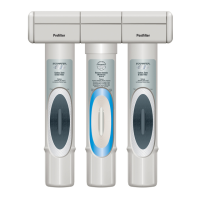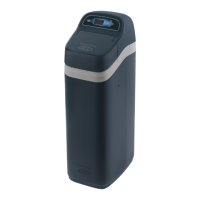Do you have a question about the EcoWater ERR 3502R30 and is the answer not in the manual?
Important safety instructions for installation and operation of the conditioner/refiner.
Notes on electrical safety, FCC compliance, and proper equipment disposal.
Explains the terms and duration of the limited warranty for parts and workmanship.
Details the guarantee for unit performance and customer satisfaction.
Guidance on plumbing connections, drain requirements, and electrical outlets.
Instructions for unpacking the unit, setting up the brine tank, and preparing for installation.
Steps for installing bypass valves and turning off the water supply.
Instructions for connecting pipes, grounding, and drain hose installation.
Details on installing brine tank overflow and managing drain hose connections.
Procedures for pressure testing, programming the controller, and initiating recharge.
Steps for sanitizing the unit and restarting the water heater after installation.
Configuring language and connecting the system to a wireless network.
Steps for connecting to the Wi-Fi network using a web browser.
Detailed steps for connecting the system to your home network using a browser.
Configuring system units (English/Metric) and setting the current time.
Adjusting salt level and iron level settings for optimal performance.
Instructions for dealers to register a new customer system online.
Steps for new customers to create an account and register their system.
Instructions on how customers can grant or revoke dealer access to their system.
Configuring language, system units, and the current time for non-Wi-Fi systems.
Setting water hardness, salt level, and iron level parameters.
Instructions for unpacking the remote and installing batteries.
Guidance on installing the remote's support stand and optional wall mounting.
Step-by-step guide to link the remote control with the conditioner/refiner.
Procedure for adding additional water treatment devices to the remote monitor.
Understanding how to navigate the remote's display and interpret status screens.
Explanation of how devices communicate within the HydroLink wireless system.
How to check wireless signal strength between the remote and devices.
Configuring the remote's language and addressing display issues.
Customizing messages displayed for connected drinking water systems.
Instructions for manually starting a recharge cycle using the remote.
Adjusting the scheduled time for automatic conditioner/refiner recharges.
Selecting which data items are displayed on the conditioner/refiner status screens.
Selecting and deselecting data items to be shown on the remote's status screens.
Changing the order in which data items appear on the status screens.
Selecting which data items can be controlled remotely.
Changing the default names of devices displayed on the remote.
Procedure for removing a device from the remote's monitoring list.
Interpreting the conditioner/refiner's status screens, including Wi-Fi and Internet connectivity.
Overview of the main menu and its subsidiary screens for system control.
Information on system alerts, reminders, flashing backlights, and long display messages.
Steps to turn on or off the lockout feature to prevent parameter changes.
Instructions for setting the salt level and type used in the conditioner/refiner.
Programming the low salt alarm notification for timely salt refills.
Procedures for manually recharging the unit or setting automatic recharge schedules.
Adjusting the system's internal clock after power loss or for accuracy.
Adjusting the automatic recharge time and the water hardness level.
Configuring the system's iron level setting for optimal performance.
Selecting which status screens are displayed during normal operation.
Choosing the display language for the conditioner/refiner interface.
Configuring the clock format (12/24 hr) and volume units (gallons/liters).
Selecting units for hardness (grains/ppm) and weight (pounds/kilograms).
Viewing model, wireless, water availability, and usage data.
Adjusting times for backwash, second backwash, and fast rinse cycles.
Setting efficiency mode and maximum days between recharges.
Activating the 97% feature for automatic recharge based on capacity usage.
Choosing modes for auxiliary output control, including Off, On, Chlorine, Bypass, Chemical Feed, Water Use, and Fast Rinse.
Configuring volume and timer settings for chemical feed equipment.
Programming service reminders and transmitting diagnostic data remotely.
Accessing diagnostic screens and resetting setup parameters or defaults.
Guidance on adding salt and resolving salt bridge issues in the brine tank.
Procedures for cleaning the nozzle/venturi assembly and maintaining the resin bed.
Steps for de-pressurizing and operating bypass valves for service or hard water bypass.
Basic troubleshooting steps and a guide for identifying common problems and causes.
Using the self-diagnostic function and clearing error codes.
Diagnosing issues related to water flow by checking the turbine count.
Verifying proper operation of recharge cycles and valve positions.
Troubleshooting hard water bypass, drain hose leaks, flooded tanks, and salty water.
Provides cabinet and two-tank model dimensions and the system's wiring schematic.
Detailed specifications including capacity, flow rates, and pressure ratings.
Information on contaminant reduction and rated capacity based on testing.
Exploded view diagram of the conditioner/refiner assembly for part identification.
List of part numbers for the conditioner/refiner assembly components.
Detailed diagram of the valve assembly for part identification and service.
List of part numbers for individual components of the valve assembly.
| Brand | EcoWater |
|---|---|
| Model | ERR 3502R30 |
| Category | Water Filtration Systems |
| Language | English |












